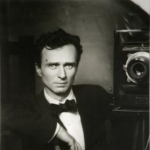Background
Arthur Beecher Carles was born on March 9, 1882 in Philadelphia, Pennsylvania, United States.

Young American Artists of the Modern School. Left to Right: Jo Davidson, Edward Steichen, Arthur B. Carles, John Marin; back: Marsden Hartley, Laurence Fellows, circa 1911, Bates College Museum of Art.
Arthur Beecher Carles was born on March 9, 1882 in Philadelphia, Pennsylvania, United States.
Arthur Beecher Carles studied at the Pennsylvania Academy of the Fine Arts between 1900 and 1907. He studied with Thomas Pollock Anshutz, Hugh Breckenridge, Henry McCarter, Cecilia Beaux, and William Merritt Chase.
Carles travelled to France in 1907, where he remained until 1910. In France, he greatly admired the works of Cézanne and Matisse, and became close friends with John Marin and Eduard Steichen. He lived in Paris for extended periods of time where he became interested in French Impressionism and modernism. During that time, Carles displayed six landscapes in the Salon d'Automne of 1908.
In March 1910 his work was included in the "Younger American Painters" show held at Alfred Stieglitz’s New York City gallery, 291. Stieglitz gave Carles his first one-man show at 291 in January 1912.
He returned to France from June to October 1912 and exhibited at the 1912 Salon d'Automne. After his return to America he exhibited at the Armory Show of 1913. He taught art at the Pennsylvania Academy of Fine Arts from 1917 to 1925 and encouraged modernist theories and techniques to his students.
In 1920-1921 he organized and co-curated exhibitions at PAFA featuring Pablo Picasso and Henri Matisse, as well as American modernists who were influenced by Post Iimpressionism and Cubism.
Carles' own work emphasized the use of color as the basis for compositional structure, a manner that made his paintings vibrant and strong. By synthesizing color and abstraction with bold, forceful brush strokes, Carles' painting foreshadowed Abstract Expressionism. He continued to teach privately in the 1930s influencing many artists including Jane Piper, Morris Blackburn, Quita Brodhead, and generations of artists that followed.
In December 1941 he suffered a stroke that left him an invalid until his death in 1952.
Arthur Beecher Carles died on June 18, 1952 in Philadelphia, Pennsylvania, United States. He was buried at the West Laurel Hill Cemetery, Bala Cynwyd, Pennsylvania, United States.
Arthur Beecher Carles was among the important artists in the development of American modernism. Known for his daring use of color and gestural bravura, he embraced the dynamism of life in the twentieth century.
Among his most famous works were "Reclining Nude" and "Woman in White". Moreover, Carles was given a retrospective exhibition at the Pennsylvania Academy in 1953, and again in 1959 at the Graham Gallery in New York.
Currently, Carles' work is in the collections of numerous national and international museums, including the Woodmere Art Museum, Hirshhorn Museum and Sculpture Garden, and The Museum of Modern Art.
Venetian Scene
Table with Flowers
Reclining Nude
Landscape
Woman in White
Abstraction
Composition (Seated Nude)
Summer Evening, France
Landscape
The Actress as Cleopatra (Mercedes de Cordoba, artist's wife)
Frances Metzger West
Woman with Red Hair
The Lake, Annecy
Silence
Gay Madness (Gay Abstraction)
Seated Woman with Upraised Arm
Portrait of Katharine Rhoades
Quotes from others about the person
Barbara Ann Boese Wolanin: "Carles was one of the most brilliant colorists in the history of American art. His paintings range in style from tonalism and Impressionism to prophecies of Abstract expressionism. His approach was intuitive. An expressionist by nature, he was guided by feeling, believing that 'accuracy is an intellectual quality while art is an affair of the emotions."
Arthur Beecher Carles had a daughter Mercedes Matter, also an artist and the founder of the New York Studio School.
Mercedes Matter was married to photographer and designer Herbert Matter.


